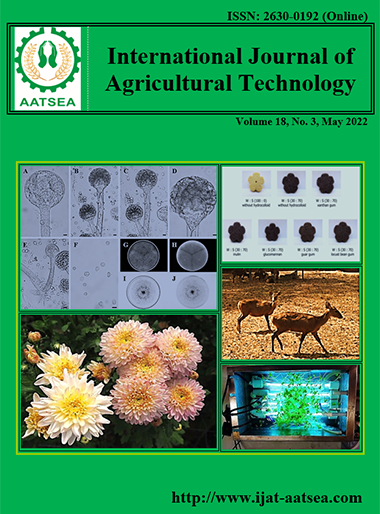Research and development of the healthy ready-to-eat strip Chinese sausage
Main Article Content
Abstract
The development of healthy ready-to-eat strip Chinese sausage products was investigated. The results showed that the cellulose gel with 25 % w/w of fat and glycerine with 60 % w/w of sucrose has no significant differences in redness (a*), yellowness (b*), texture (firmness and toughness), and sensory score (appearance, color, taste, flavor and overall liking) compared to the control sample (p≥0.05). However, the product texture score was lower than the control sample (p<0.05). Secondly, the product shelf life in the vacuum-packed was studied with accelerated shelf-life testing (AST) at 35 and 45 ºC for four weeks. Throughout the storage period, the water activity was 0.66-0.68, and the TBARS value was 0.13-0.21 mg malonaldehyde/kg sample. The results suggested that the product with 25 % cellulose gel (w/w of fat) and 60 % (w/w of sucrose) glycerine, vacuum packed in a nylon bag (per piece) and topped with a polyethylene bag (5 pieces/pack) stored at room temperature (28±2 ºC) for two months form Q10 calculation. Finally, the final product had shown high sensory scores in all attributes. In addition, 76.47 % of a consumer decided to purchase the product
Article Details

This work is licensed under a Creative Commons Attribution-NonCommercial-NoDerivatives 4.0 International License.
References
Borch, E., Kant-Muermans, M. L. and Blixy, Y. (1996). Bacterial spoilage of meat and cured meat products. International Journal of Food Microbiology. 33:103-120.
Chen, J., Hu, Y., Wen, R., Liu, Q., Chen, L. and Kong, B. (2019). Effect of NaCl substitutes on the physical, microbial and sensory characteristics of Harbin dry sausage. Meat Science, 156:205-213.
Costa, A. I. A., Schoolmeester, D., Dekker, M., and Jongen, W. M. F. (2007). To cook or not to cook: a means-end study of motives for choice of meal solutions. Food Quality and Preference, 18:77-88.
Domínguez, R., Pateiro, M., Agregán, R. and Lorenzo, J. M. (2017). Effect of the partial replment of pork backfat by microencapsulated fish oil or mixed fish and olive oil on the quality of frankfurter type sausage. Journal of Food Science and Technology, 54:26-37.
Olsen, N. V., Sijtsema, S. J. and Hall, G. (2010). Predicting consumers’ intention to consume ready-to-eat meals. The role of moral attitude. Appetite, 55:534-539.
Ozvural, E. B. and Vural, H. (2008). Utilization of interesterified oil blends in the production frankfurters. Journal of Food Science, 59:725-733.
Plahar, W. A., Okezie, B. O. and Annan, N. T. (2003). Nutritional quality and strage stability of extruded weaning foods based on peanut, maize and soybean. Plant Foods for Human Nutrition, 58:1-16.
Suksripisat, C. (2016). Product and Storage of Ready-to-eat Reduced Chinese Sausage Using Hurdle Technology (Master Thesis). Thammasat University, Thailand.
Wang, F. S., Jiang, Y. N. and Lin, C. W. (1995). Lipid and cholesterol oxidation in Chinese-style sausage using vacuum and modified atmosphere packaging. Meat Science, 40:93-101.


